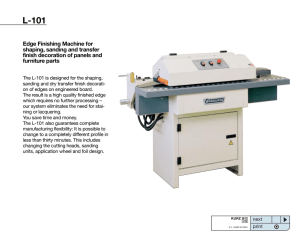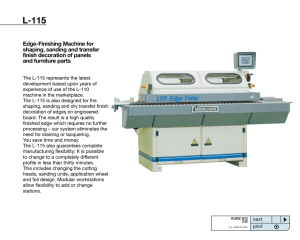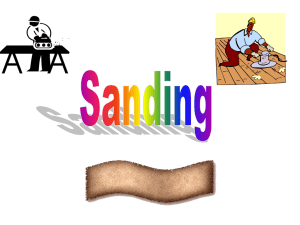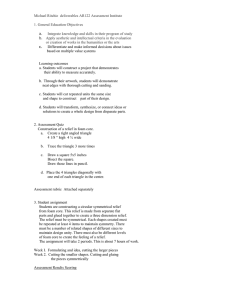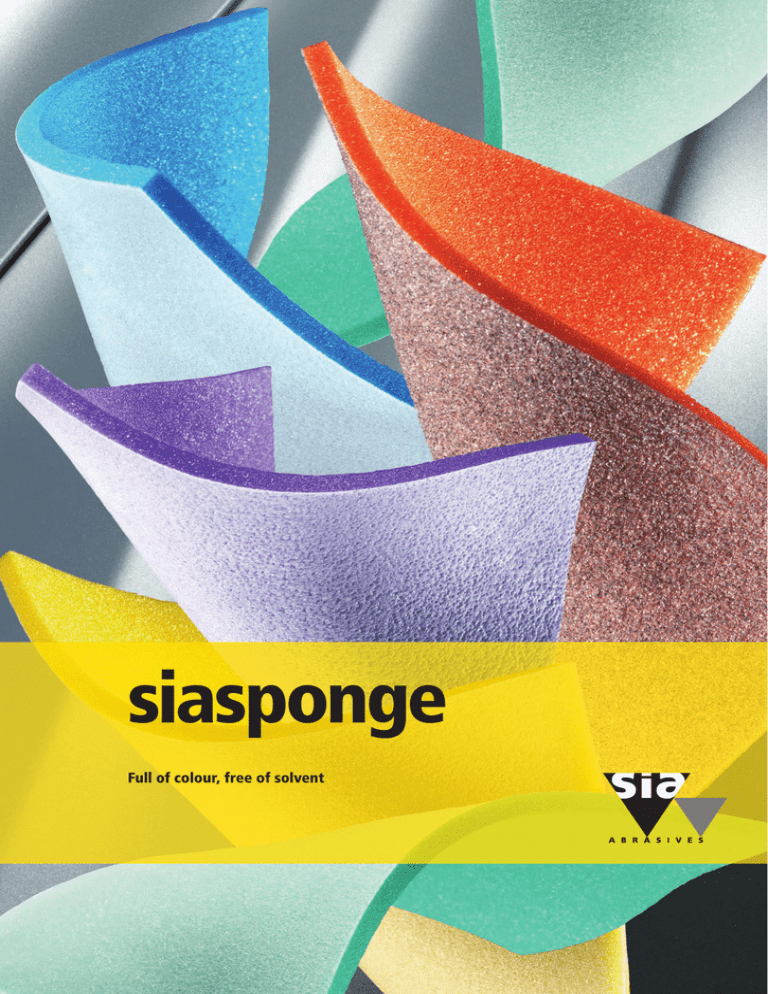
siasponge
Full of colour, free of solvent
The colour concept
Uniform colour system for greater process reliability
Thanks to their high-grade materials and careful manufacture, the longlasting foam abrasives from sia Abrasives can be used multiple times.
However, during and after use, product (grit) identification can be difficult
due to dust. Feeling the grit or even measuring the grit does not guarantee
identification because the grit is worn.
Straightforward, easy-to-understand work and sanding processes are
crucial in preventing mistakes during surface treatment and keeping the
sanding process as quick and uncomplicated as possible. To help secure
greater safety of application, sia Abrasives has developed a uniform colourcoding scheme that is simple, logical and easy to understand without the
need for a lot of words. Each foam colour represents a specific grit range
or grade. This applies across all materials and all conversion forms for every
sanding application. Maximum process reliability – your key to a perfect
surface.
Colour concept with big role models
The basic colour coding we employ can trace its origins back to colour
theory, which has been developed by such well-known names as Isaac
Newton or Johann Wolfgang von Goethe over the course of the last few
centuries.
Leonardo da Vinci also noted how colours influence each other when
viewed side by side.
But it was not until Isaac Newton came along in the 17th century that the
fundamentals for understanding human colour perception were defined –
not only because he described a beam of light's path through a prism, but
because he also understood the psychological component of colour vision.
Goethe's thoughts on the topic of colour stretch back to the 18th century.
His colour system was based on the notion that blue and yellow are not
actually pure colours, but instead represent the opposing forces of light
and dark (blue = darkness, yellow = lightness). All other colours then lie
between these two poles. Modern colour theory is still based on these
concepts today and plays an important role in more than just the painting
and varnishing trade.
Yellow
Green
Orange
Blue
Red
siasponge grade
Fine
Coarse
Violet
medium
The siasponge colour concept
The grit range classifications used for siasponge products are based on
colour theory. The various grades of foam abrasives have been subdivided
based on the colours of the spectrum here.
fine
superfine
ultrafine
The coarsest abrasives (medium) are therefore orange, working all the way
down to the finest grit (microfine), which comes in violet.
Foam colour
Grade
Old product
Application examples
Orange
medium
K280, medium
Keying of plastics / composites prior to application of primer
Yellow
fine
K500, fine
Keying of primer coats prior to application of filler
Green
superfine
K800, extrafine
Fine sanding of filler (in hard-to-reach areas)
Blue
ultrafine
K1000, superfine
Intermediate lacquer sanding
Violet
microfine
K1500, microfine
Matting of paint or varnish
2
microfine
The colours of the spectrum
Back in the 17th century, Isaac Newton was able to demonstrate the
splitting of "white" light into the colours of the spectrum. As a light beam
strikes a prism, the various wavelengths are refracted to varying degrees.
This made it possible to demonstrate that white light is a mix of a large
number of individual colours. Spectral colours are pure light of one wavelength and the most intense, pure colour in each tone. This is how we get
the light spectrum from red, through orange, yellow, green and blue, all
the way up to violet.
Comparison test of siasponge grades with 1950 siaspeed grit ranges
microfine
microfine
ultrafine
ultrafine
siasponge
soft pad
(EVA / PU-FOAM)
superfine
superfine
fine
fine
medium
medium
1950 siaspeed
180
240
280
320
400
500
600
800
1000
1200
1500
Comparison test under the following conditions:
Test method: LTM9.0 – sia Abrasives application simulation
Test equipment: 59.275 / Berta, Material: DuPontTM Corian®
Surface roughness measurement (Rz) as per DIN EN ISO 4287
3
Reasons for using foam abrasives
Advantages of foam as a carrier material
Maximum conformability
Due to their conformability, foam abrasives are the ideal choice for areas
that are difficult to access and have profiled surfaces.
Hard-to-reach areas, such as door handle depressions, bumpers and
radiator grilles, are ideal fields of application for the siasponge. Unlike
conventional sandpaper, foam abrasives can be folded without creating
permanent creases, which allows a more consistent surface finish due
to improved grain consistency without swirl marks.
The benefit for you:
– Moulds itself to the work piece, also when sanding hard-to-reach areas
– No damage to the surface due to folds, kinks or ridges
The benefit for you:
– Perfect surface finishes thanks to pressure-distributing foam
– No undercutting in intermediate sanding due to application of
excess pressure
Low clogging thanks to the 3D effect
The combination of a more flexible binder and soft carrier material has
further improved the clogging characteristics of foam abrasives.
Due to the new flexible binder and optimised abrasive grain distribution,
improved 3D flexing means sanding dust is continuously removed from
the sanding face leading to longer life.
The benefit for you:
– Longer useful life thanks to less clogging
– Suitable for multiple uses
4
Pressure distribution of foams
16
14
12
Force (N)
Optimised pressure equalisation
When sanding with foam abrasives, the focus is not on removing as much
material as possible, but rather on optimising the surfaces. It is vital to
achieve an absolutely smooth and even result when preparing surfaces for
subsequent painting or varnishing. If the goal is to achieve a perfect workpiece surface finish with low scratch depth, using conventional sandpaper
can be too aggressive or result in an uneven finish. Using foam as a carrier
material in conjunction with a flexible binder resin, the applied force is
dissipated throughout the 3-D structure creating a more consistent and
even pressure of grit on substrate.
The abrasive grain then does not cut into the substrate as deeply and
breaks off less. As such, less material is removed and no sanding through
of the material occurs at the edges. Instead, we achieve a more consistent
surface.
10
8
6
4
2
0
0
0,2
0,4
0,6
0,8
1,0
1,2
1,4
1,6
1,8
Distance (mm)
PU foam (e.g. 7970 siasponge soft)
EVA foam (e.g. 7972 siasponge soft)
The larger the area between the curves, the more local energy is absorbed and transmitted
uniformly. However, if the two curves are almost superimposed on top of one another, the
pressure is transmitted directly to the surface being sanded.
Grit
Binder resin
Foam
An overview of the benefits for you
Sustainable and user-oriented
With a view to sustainable production processes, solvent-free binder resins
are used in the manufacture of siasponge abrasive sponges. sia Abrasives is
therefore committed to avoiding health and environmental risks, reducing
unpleasant odours at the workplace and reducing potentially hazardous
or explosive vapours.
The advantages of siasponge at a glance:
– Never mix up your sanding grits again
– Highly flexible
– No discolouration of the grit side
– No bulging of the pad corners
– No acrid solvent odour
– No folds, no bends
– Consistent scratch pattern due to improved grain consistency
– Suitable for highly versatile deployments with plastics, composites,
paints, varnishes, old lacquers, fillers, primers
5
7970 siasponge soft pad (PU)
For wet sanding applications
The siasponge soft pad is also ideal for sanding hard-to-reach areas, such
as radiator grilles, door handle depressions or bumpers. The pressuredistributing foam is ideally suited to wet sanding applications and delivers
a perfect surface finish even in the finest grit ranges.
siasponge soft pad
medium
siasponge soft pad
fine
siasponge soft pad
ultrafine
Dry, damp and wet sanding applications
– Sanding of plastics prior to application of primer
– Keying of primer coats prior to application of filler
– Fine sanding of filler
– Keying without changing the surface shape
– Producing a matt finish on varnishes or paints
– Intermediate lacquer sanding
Product
Pad
6
Product profile
Dimensions:
Coating:
Grit type:
Binder resin:
Carrier material / backing:
115 x 140 x 5 mm
Single-sided
Aluminium oxide
Flexible
PU (polyurethane) – open foam structure
siasponge soft pad
superfine
siasponge soft pad
microfine
Advantages of PU foam
– Can be used wet or dry
– Pressure is distributed uniformly
– Highly flexible
Foam colour
Grade
Article ID 20 pcs. (dispenser)
Article ID 250 pcs. (bulk pack)
Orange
medium
0070.1131.01
0070.1131.02
Yellow
fine
0070.1132.01
0070.1132.02
Green
superfine
0070.1134.01
0070.1134.02
Blue
ultrafine
0070.1135.01
0070.1135.02
Violet
microfine
0070.1136.01
0070.1136.02
Manual sanding of contours and edges
e.g. wet matting of painted car body parts
Manual sanding of hard-to-reach areas
e.g. wet sanding of paintwork repair spots
Optimum distribution of applied pressure
The airy and open cell structure of PU foam allows the contact pressure
applied to be more evenly distributed than when using EVA foam or
conventional sandpaper.
The pressure exerted by the fingers is dissipated more evenly by PU
foam giving a more consistent finish in comparison with classic abrasives.
This means "fingerprints" or traces of over/under sanding can be avoided.
Manual sanding of special shapes and contours
e.g. preparation for painting over composites, wet sanding
Finger
Foam
Binder resin
Abrasive grain
Sanding finish
7
7972 siasponge soft pad (EVA)
For dry sanding applications
The siasponge soft pad is ideal for sanding difficult-to-reach areas, such as
radiator grilles, door handle depressions or bumpers. Unlike conventional
sandpaper, the soft pad can be folded without creating permanent folds or
kinks. This prevents damage to the varnish or paint.
siasponge soft pad
medium
siasponge soft pad
fine
siasponge soft pad
ultrafine
Dry sanding applications
– Sanding of plastics prior to application of primer
– Keying of primer coats prior to application of filler
– Fine sanding of filler
– Keying without changing the surface shape
– Producing a matt finish on varnishes or paints
– Intermediate lacquer sanding
Product
Pad
8
Product profile
Dimensions:
Coating:
Grit type:
Binder resin:
Carrier material / backing:
115 x 140 x 5 mm
Single-sided
Aluminium oxide
Flexible
EVA (ethyl vinyl acetate) –
closed foam structure
siasponge soft pad
superfine
siasponge soft pad
microfine
Advantages of EVA foam
– Improved tear-resistance
– For machine-based deployments
– Highly flexible
Foam colour
Grade
Article ID 20 pcs. (dispenser)
Article ID 250 pcs. (bulk pack)
Orange
medium
0070.1137.01
0070.1137.02
Yellow
fine
0070.1138.01
0070.1138.02
Green
superfine
0070.1140.01
0070.1140.02
Blue
ultrafine
0070.1141.01
0070.1141.02
Violet
microfine
0070.1142.01
0070.1142.02
Manual sanding of hard-to-reach areas
e.g. keying/sanding out of plastic parts, intermediate sanding of
hard-to-reach areas, dry sanding
Manual sanding of contours and edges
e.g. preparation for painting over painted workpieces, dry sanding
Manual sanding of special shapes
e.g. preparation for painting over composites, dry sanding
Tip
How can I tell whether a pad is an
EVA foam or PU foam pad?
EVA foam:
– Closed-pore structure
– Softer; you can immediately feel the base layer
– Tear-resistant
– B ecomes wet and slippery in contact
with water
– T he serial number 7972 is printed on the
back of the sponge
– B ecomes deformed when exposed to heat
in excess of 120 °C
PU foam:
– Open-pore structure
– Harder; pressure is distributed more
effectively
– Does not become wet or slippery
in contact with water
– The serial number 7970 is printed
on the back of the sponge
– More heat-resistant
9
7972 siasponge soft disc
The flexible foam disc
for dry, damp and wet sanding applications
Not only can the siasponge soft disc be used both wet and dry, its closedpore foam structure also allows it to adapt flexibly to any contour, which in
turn reduces the risk of tears and sanding through the material. In addition
to this, it can be placed directly onto the machine without the need for an
intermediate pad.
siasponge soft disc
medium
Dry, damp and wet sanding applications
– Fine sanding of bodyfiller
– Smoothing down filler
– Matting of varnishes
– Sanding of composite parts
– Intermediate lacquer sanding
– Wet and dry sanding
Disc
10
Back:
siasponge soft disc
fine
siasponge soft disc
ultrafine
Product
Product profile
Dimensions:
Coating:
Grit type:
Binder resin:
Carrier material / backing:
Ø 150 x 5 mm, 15-hole
Single-sided
Aluminium oxide
Flexible
EVA (ethyl vinyl acetate)
closed foam structure
Velour (red)
siasponge soft disc
superfine
siasponge soft disc
microfine
Advantages of foam discs
– No intermediate pad required
– Can be used wet or dry
– Low risk of sanding through on edges
– Adapts to fit any contour
– Less tearing
Foam colour
Grade
Article ID
Sales package qty
Orange
medium
0070.1153.01
20 pcs.
Yellow
fine
0070.1154.01
Green
superfine
0070.1156.01
Blue
ultrafine
0070.1157.01
Violet
microfine
0070.1158.01
Machine applications for shapes and contours
e.g. final filler finish sanding prior to painting car body parts, dry sanding
Machine sanding of rounded areas
e.g. cleaning and polishing bowling balls, wet or dry sanding
Tear-resistance / Edge stability
180
160
140
120
Force (N)
Tear-resistance of various foams
Two key distinguishing features of foam abrasives are their tear-resistance
and edge stability. Thanks to its closed cell structure, EVA foam boasts
greater tear-resistance and toughness than PU foam. In addition, it also
offers lower distribution of energy than (open cell structure) PU foam –
please also refer to the illustration on page 7.
The illustration on this page shows typical elongation properties of our
PU and EVA foam as a function of applied force.
100
80
60
40
20
PU foam
EVA foam
0
0 50 100150200250300350
Elongation (%)
11
Your Key to a Perfect Surface
www.sia-abrasives.com
Art. ID: 0020.7574.01 · 04.220.en.0914 · © by sia Abrasives Industries AG – All rights reserved

